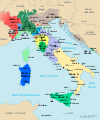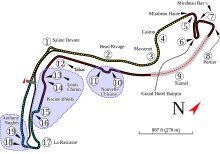Portal:Monaco
The Monaco Portal
Welcome! — Bienvenue! — Benvegnüu!

Monaco, officially the Principality of Monaco, is a sovereign city-state and microstate on the French Riviera a few kilometres west of the Italian region of Liguria, in Western Europe, on the Mediterranean Sea. It is a semi-enclave bordered by France to the north, east and west. The principality is home to 38,682 residents, of whom 9,486 are Monégasque nationals; it is recognised as one of the wealthiest and most expensive places in the world. The official language is French; Monégasque, English and Italian are spoken and understood by many residents.
With an area of 2.08 km2 (0.80 sq mi), Monaco is the second-smallest sovereign state in the world, after Vatican City. Its population of 38,367 in 2023 makes it the most densely-populated sovereign state, trailing only Macau. Monaco has the world's shortest coastline: 3.83 km (2.38 mi). The principality is about 15 km (9.3 mi) from the border with Italy and consists of nine administrative wards, the largest of which is Monte Carlo.
The principality is governed under a form of constitutional monarchy, with Prince Albert II as head of state, who wields political power despite his constitutional status. The prime minister, who is the head of government, can be either a Monégasque or French citizen; the monarch consults with the Government of France before an appointment. Key members of the judiciary are detached French magistrates. The House of Grimaldi has ruled Monaco, with brief interruptions, since 1297. The state's sovereignty was officially recognised by the Franco-Monégasque Treaty of 1861, with Monaco becoming a full United Nations voting member in 1993. Despite Monaco's independence and separate foreign policy, its defence is the responsibility of France, besides maintenance of two small military units. (Full article...)
Selected location article

The Jardin St. Martin are located in the Monaco-Ville ward of Monaco. The gardens are made up of a series of paths on the south west face of the Rock of Monaco. They have an estimated area of 11,200 square meters (1.12 hectares). Flora include Aleppo pine trees and yellow agaves in its terraces with medieval fortifications also featuring in the gardens. Archaeological finds in the gardens have been dated to the Holocene era.
François Cogné's bronze statue of Prince Albert I as a sailor stands at the centre of the gardens. (Full article...)Selected pictures
Selected ward
Selected environment article

The Tête de Chien (Monégasque: Testa de Can; "Dog's Head") is a 550 m (1,804 ft) high rock promontory near the village of La Turbie in the Alpes-Maritimes department of France. It overlooks the Principality of Monaco, and is the highest point on the Grande Corniche road.
The American diplomat Samuel S. Cox, in his 1870 travel book Search for Winter Sunbeams in the Riviera, Corsica, Algiers and Spain wrote that the Tête de Chien more resembled a tortoise than a dog's head, and believed that Tête de Chien, or rather Testa de Can, was a corruption of Testa de Camp ("Field Head"), as it was where Caesar stationed his troops after the conquest of Gaul. Vere Herbert, the heroine of Ouida's 1880 novel Moths is described as living under the Tête de Chien, "...within a few miles of the brilliant Hell [Monaco]." (Full article...)List of articles
|
|---|
Selected arts article
"Un banc, un arbre, une rue" (French pronunciation: [œ̃ bɑ̃ œ̃n‿aʁbʁ yn ʁy]; "A Bench, a Tree, a Street") is a song recorded by French singer Séverine, with music composed by Jean-Pierre Bourtayre and French lyrics written by Yves Dessca. It represented Monaco in the Eurovision Song Contest 1971 held in Dublin, resulting in the country's only ever win in the contest. (Full article...)
Selected religion article

The history of the Jews in Monaco goes back at least a century, most notably to the time of the Holocaust. Monaco had a very small Jewish presence before World War II, numbering approximately 300 people. During the war, the principality's government issued false identity papers to its Jewish residents to protect them from Nazi deportation. Prince Louis II refused to dismiss Jewish civil servants and protected Édouard de Rothschild from deportation. However, Monaco's police arrested and turned over 42 Central European Jewish refugees to the Nazis. Sixty Jews were arrested 27–28 August 1942, and ninety in total, according to The Algemeiner.
In 1948, the Association Cultuelle Israelite de Monaco was founded as the official organization of Monaco's Jewish community, and it provides the community with a synagogue, Hebrew school and kosher food store. Today's Jewish community in Monaco consists primarily of retirees from France and the United Kingdom, and there is also a small population of North African and Turkish Jews. (Full article...)
Selected sports article
The 2011 Monaco Grand Prix, formally the Formula 1 Grand Prix de Monaco 2011, was held on 29 May 2011 at the Circuit de Monaco in Monte Carlo, Monaco. Sixth round of the 2011 Formula One season, the 78 lap race was won by the championship leader, Red Bull Racing's Sebastian Vettel who started from pole position. Ferrari's Fernando Alonso was second and McLaren's Jenson Button third.
Winner Vettel extended his lead in the World Drivers' Championship to 58 points over Lewis Hamilton who was sixth. Mark Webber finished fourth and maintained third place in the championship, six points behind Hamilton in third and three ahead of Button. In the World Constructors' Championship, Red Bull extended its lead over McLaren to 61 points, with Ferrari being a further 68 points behind. (Full article...)
Selected education article
The American College of Monaco was a tertiary institution located in Monte Carlo, Monaco, that operated from 1968 until 1970. The college offered a four-year degree program and was reportedly established by the Principality at the request of Princess Grace.
The college held classes in the Hotel Hermitage behind the Hotel de Paris, and the famous Monte Carlo Casino during its first academic year. After that, the school relocated to the Hotel Splendid, on the border of Beausoleil. Prince Rainier III was the Chancellor of the School, and the famous oceanographer, Jacques Yves Cousteau, was a member of its Board of Academic Overseers. (Full article...)
Selected transportation article

Port Hercules (French: Port Hercule [pɔʁ ɛʁkyl]) is the only deep-water port in Monaco. The port has been in use since ancient times. The modern port was completed in 1926, and underwent substantial improvements in the 1970s. It covers almost 40 acres (160,000 m2), enough to provide anchorage for up to 700 vessels. The port is located in the La Condamine district. Harbour pilots are required for all vessels longer than 30 metres. The depth of water in the harbour ranges from seven metres for standard berths and up to 40 metres for the outer piers and cruise ship docks. (Full article...)
Selected biography
Maurice Revelli (born 4 September 1964) is a Monegasque former professional footballer who played as a defender. (Full article...)
Did you know...
- ... that Ron Monaco, described as the "longest of long shots", became a starter in the NFL having been just a backup in college?
Related portals
Need help?
Do you have a question about Monaco that you can't find the answer to?
Consider asking it at the Wikipedia reference desk.
Categories
Get involved
For editor resources and to collaborate with other editors on improving Wikipedia's Monaco-related articles, see WikiProject Monaco.
Topics
Associated Wikimedia
The following Wikimedia Foundation sister projects provide more on this subject:
-
Commons
Free media repository -
Wikibooks
Free textbooks and manuals -
Wikidata
Free knowledge base -
Wikinews
Free-content news -
Wikiquote
Collection of quotations -
Wikisource
Free-content library -
Wikiversity
Free learning tools -
Wikivoyage
Free travel guide -
Wiktionary
Dictionary and thesaurus

























































